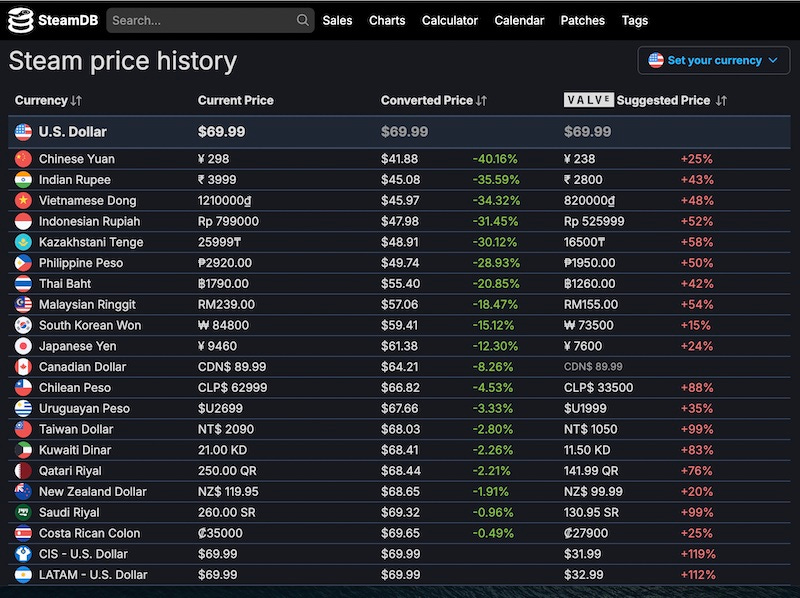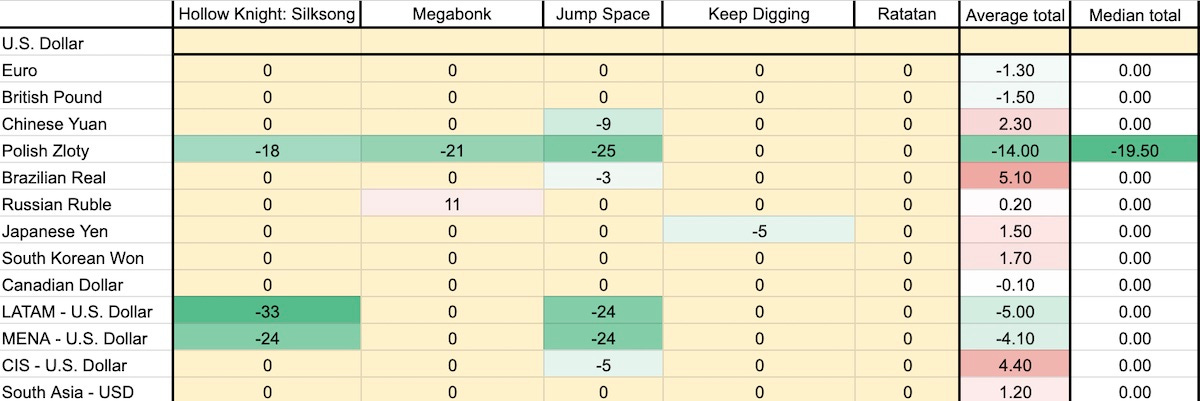Does Steam have its regional pricing recommendations right?
Publikováno: 31.10.2025
If not, what should you do about it? Also: a bunch of new Steam releases & the latest news.
[The GameDiscoverCo game discovery newsletter is written by ‘how people find your game’ expert & company founder Simon Carless, and is a regular look at how people discover and buy video games in the 2020s.]
It’s later, not earlier, in this spooky week, so time to return to GameDiscoverCo newsletter goodness. Our lead story is about regional game pricing - and we’ll be analyzing Steam debuts - from Arc Raiders to The Outer Worlds 2 & beyond - for our GDCo Plus & Pro subscribers later on.
Before we start, did you know that a giant flying Mario balloon is heading for the 99th Macy’s Thanksgiving Parade? It measures 51 feet long, 37 feet wide, and 43 feet tall. Let’s just hope Mario doesn’t end up like Sonic’s balloon at the 1993 parade, huh? (Sure, you ‘gotta go fast’, but there was torn fabric, lamp-post damage, and injuries…)
[WANT LOTS MORE DATA? Companies, get much more ‘Steam deep dive’ & console data SaaS access org-wide via GameDiscoverCo Pro, as 80+ have. And signing up to GDCo Plus gets (like Pro!) the rest of this newsletter and Discord access, plus ‘just’ basic data & more. ]
Game discovery news: Battlefield, Arc Raiders time
OK, let’s get going here, with a little bit of game discovery & platform news for your cerebellum:
The latest Footprints.gg ‘trad media’ charts (from ICO!) show the most coverage for Battlefield 6 (yet again, thanks to REDSEC’s launch?), followed by the just-debuting The Outer Worlds 2, the just-announced Halo: Campaign Evolved, and.. only #6 for Arc Raiders, despite it being a huuge launch? Huh.
The folks at Stream Hatchet have collaborated with GDCo again on a new analysis, looking at a “group of perennial [Steam] sellers” and their streamer support. One notable thing? “How games with limited content (i.e. campaign-focused games) are able to compete with the live service titles that do make it onto this list.”
Roblox fiscal results? Ben Sarraille explains how they’re a monster: “👤 151.5 million avg DAUs (+70% YoY);💰 $1.36 billion in revenue (+48% YoY); 👾 $427.9 million paid to devs (+85% YoY); 🎩 35.8 million Monthly Active Payers (+88% YoY).” Shares took a dive because of margin decline, but a $78 billion market cap ain’t bad.
Third-party Steam key distro service Rokky has surveyed game pubs/devs about the state of PC distribution: “88% of studios say Steam accounts for over 75% of their revenue. 72% feel Steam effectively exists as a monopoly.” 48% of them have distributed via Epic Games Store, 10% with GOG, and only 8% with itch.io.
Lots of spicy ‘game development lies’ from Paul Kilduff-Taylor here, including the ‘if you don’t get a hit, you should quit’ approach to games: “While hits generate the majority of revenue and create the greatest long-term industry impact, they are often produced by teams of people who have already taken multiple shots.”
Xbox’s latest results? Not stellar compared to the rest of Microsoft, with revenue up 17% for MS as a whole, but down 2% in the game-related division. However: “CFO Amy Hood noted that gross margin dollars in the segment increased 11% year-on-year, however, driven by the company’s shift to ‘higher margin businesses’.”
Splitting it into segments, “Xbox Content and Services revenue increased 1%, which the company attributed to a strong year prior”, with various PS5 launches like Sea Of Thieves. But Xbox hardware revenue is down 29%, despite significant YoY price increases. (Yes, it’s a) low-margin and b) fading out…)
GameDeveloper.com took a look at topdown extraction shooter Escape From Duckov’s stand-out success - >2m players on Steam already, done by a tiny team at big Chinese firm Bilibili, which says: “That satisfying loop of ‘loot, upgrade, repeat’ gives steady positive feedback - way more relaxing than the stress of PVP shooters.”
Streaming showcases? Yes, there’s been some! Firstly, the ID@Xbox Showcase for October had a bunch of announces, including the very silly Egging On coming to Game Pass. And DreadXP and The Mix’s Horror Showcase was… horrifying. (There were also lots of IGN Fan Fest reveals across both TV/movies and games.)
Epic’s lawsuit-a-palooza has claimed another U.S. mobile platform victim, as “from today, Google can no longer restrict the use of alternative payment systems in the US [Android] Play store, or force developers to use Google Play Billing.” After similar U.S. iOS changes in May, let a million off-platform payment solutions bloom…
We don’t link much (any?) ‘games and AI’ stuff, but sure, we’ll make an exception for the sure-to-be controversial Owen Mahoney: “Each previous wave of new technology in games multiplied the number of creators: from thousands in the PC age, to hundreds of thousands in the console and online era, to millions in the mobile wave, to tens of millions in the age of UGC platforms like Roblox. AI will multiply that again.”
Microlinks: YouTube will age-restrict more content showing ‘[very] graphic violence’ in video games; the PlayStation Plus monthly games for Nov. 2025 include Stray, EA Sports WRC 24, Totally Accurate Battle Simulator; tabletop console Board is a board/video game hybrid, launching next month for $500.
Does Steam have regional price recommendations right?
Whether you’re a small, medium, or giant game creator in this global market, getting your regional pricing right is important! Get it wrong, and you may sell less copies & have players in those countries all over your forums and reviews, complaining…
GDCo recently did a little consulting on regional pricing strategies, so we thought we’d do a higher-level version for you all. And as a starting point, we’re using Steam’s recommended regional pricing, last updated in Oct. 2022. This handy tool allows you to quickly release a game without even thinking about pricing - just select & go!
And as Valve noted at the time, the “process for price suggestions goes deeper into the nuts and bolts of what players pay for the goods and services in their lives”, not just real-time reflections of exchange rate fluctuations.
However, Steam’s “commitment to refresh these price suggestions on a much more regular cadence” back in 2022 has not been followed through, with one major exception. In November 2023, after exchange rate/hyperinflation issues in both Argentina & Turkey, Steam changed its store so that the currency used in those countries is USD.
Thus, they created a ‘bucket’ of countries - LATAM - USD and MENA - USD - that you automatically get a US dollar-denominated suggested price for. There’s also others, like a CIS - USD suggestion for various former Russian satellites. (This is a clever solution for a host of smaller countries prone to currency fluctuations.)
We believe that this USD fix was meant to obviate the need to more regularly update suggested pricing elsewhere. But what are devs actually doing? Do they change Valve’s suggestions often? We can see this via the excellent SteamDB site, which shows that info on package pages. Here’s some of Borderlands 4, for example:
You can see what’s going on: there’s a current price, and then a difference compared to Valve’s suggested price. For example, the Chinese price for this game - 298 yuan - is 25% higher than Valve’s suggestion of 238 yuan.
So we’ve grabbed 10 indies and 10 AA/AAA titles released on Steam in Sept. 2025, and looked at their pricing vs. Steam recommendations(Google Drive doc). Showing all ten would be a bit dense, so here’s five of the indies with the average & median results for all ten, prioritizing the high-market share currencies:
As you can see, indies keep the vast majority of Steam’s suggestions. Why? They likely still make sense in 2025! The only big fluctuations are as follows:
Polish zloty recommended price is set >20% cheaper by ~half of the games: Poland is 2.3% of all Steam sales, according to GDCo, and exchange rate shifts since 2022 by ~30% have led to pressure campaigns for devs to change pricing. (We think Steam should one-time adjust this, without changing others.)
LATAM and MENA/USD rec. prices are set 20-30% cheaper by a couple of games: we can see the argument here, since some of the currencies here are still inflating aggressively, and consumers have to pay in USD. This is less common, though. The average change among the 10 games we picked was -5%.
Anyhow, our view for the average indie in 2025 is: take all Steam recs, but remember to price down your Polish version by ~20-25%, and make other ad-hoc changes if you want. (You may disagree, but Steam’s still making it easy for us.)
The picture is somewhat different for AA/AAA games. (Are these due to outdated AAA pricing structures, or are these adjustments the right thing?) Here’s five of the ten, and you can see them all in the full .DOC:
Actually, USD, Euro, and GBP are all pretty similar to Steam recommendations. But here’s some differences:
Chinese yuan averages >26% Valve’s suggestion of ~63% of USD price: we think this is reasonable, and has precedent for large AAA productions. (Heck, Chinese standout Black Myth Wukong is 35% more than Valve’s suggested price.) But it does lead to a bigger gulf between cheaper indies and expensive AAAs.
Brazilian Real averages 67% more than Valve’s price suggestions (!): Brazil is ~3.2% of all Steam unit sales, too! Perhaps historically expensive AAA prices is down to some large import taxes in the past, or there’s some inflation-related effect in here. We were surprised.
Many AAA titles don’t participate in the ‘bucket of countries’ approach: for example, Sonic Racing: Crossworlds just decided to keep its MENA-USD price at the same price in USD as the game ($70). We presume this is because the approach is alien to them, or they don’t want to create ‘loopholes’ in some way.
There’s a few other shifts - Japanese yen is 14% more expensive than Steam’s suggestions, for example. And we’d presume some of this is based on recent exchange rate shifts - it’s always OK to minorly tweak pricing based on that!
But the main takeaway here: in certain territories, AAAs should be careful that they’re not making their games way less sale-able because dynamic indies took Steam pricing suggestions and they didn’t? But we’re sure everyone has strong views on pricing - feel free to fire them at us…





